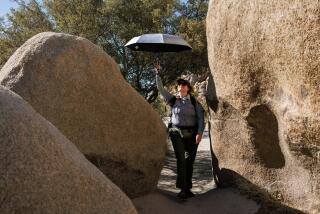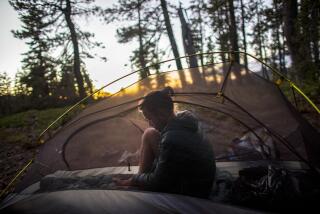The ‘duh’ factor
- Share via
Ever burn a pot of snow? Be advised: Some seemingly simple backpacking tasks aren’t. And some of those tricks Grandma passed on from her Girl Scout days -- digging a gutter around a tent, building a big wood fire -- may now get you run out of camp by the environmentally enlightened. Even choosing a campsite requires thought before you roll out a ground cloth. Here are five tips to keep in mind as snows melt and trails entice.
Choosing a site: Think about where you are, not just where you want to sleep. Most backpackers know to stay at least 200 yards from rivers or lakes, but they don’t consider what’s under their boots. “People want to backpack in a place with a view,” says Deb Schweizer, a ranger at Yosemite National Park who has logged about 5,000 miles. “That can be done, but keep in mind that meadows and subalpine meadows have habitats that are very fragile. It takes time for them to recover from something as simple as a boot print, so you can imagine what a tent does.” When camping above the tree line, particularly in spring or early summer when plants are blooming, she recommends pitching your tent on rocky outcroppings or sandy areas. The seventh edition of “Mountaineering: Freedom of the Hills” ranks eight ground conditions and levels of impact from best (an established campsite on hardened ground) to worst (alpine meadows).
Staking a tent: It’s easy to stake your tent when the ground cooperates, but sometimes the surface suffers from the Goldilocks syndrome: too hard or too soft. Or maybe a stiff wind is pulling your stakes up as quickly as you pound them into the ground. Let extra cord be your new best friend, says Christopher Fraenza, a manager at Adventure 16 in West Los Angeles. “Fifty feet of cordage takes up hardly any space in your pack,” Fraenza says. He recommends cutting it into small lengths, threading it through the tent or fly grommet and tying the cord around a heavy rock. In “The Complete Walker IV,” veteran backpacking author Colin Fletcher improvises with cord, sticks and rocks.
Storing food: Most backpackers have already given up the cumbersome task of hanging food in favor of bear canisters. The hard plastic Garcia canister is the most widely available and also has been approved by park and forest officials for use in parts of the Sierra where canisters are required. But this simple solution has one potential flaw: It might not fit in your backpack. “It fits in most internal-frame packs that have at least 4,000 cubic inches capacity,” Fraenza says. Those with smaller or older-style packs may need to strap the canister to the top or bottom, less than ideal places to try to balance heavy weight. And the slick sides make the canister almost impossible to lash to a pack without buying the additional carrying pouch.
Digging a loo: This routine is to dig a “cat hole” no more than 8 inches deep, mix the waste with some soil and cover the hole. But it’s not ideal in alpine areas or desert canyons where the waste won’t easily break down or where it may contaminate the habitat. “In high-use areas, I recommend packing it out,” Yosemite’s Schweizer said. For the crowded Mt. Whitney Trail, rangers will be handing out waste bags as part of a voluntary “pack it out” policy.
Melting snow: So back to that “burned” pot of snow. If you start by heating a big chunk of dry snow, you may wind up with water that has a scorched or metallic taste. Put a little bit of water in the bottom of the pot and add the snow slowly to minimize the scorch factor. To keep your source of snow pristine, set aside an area away from pathways to keep people from stomping around on the white stuff you plan on ingesting. And remember, just because the water comes from snow in the backcountry doesn’t mean it’s potable. Filter it, treat it with iodine or boil it for at least a minute.
Oh, and these days, backcountry types almost universally favor camp stoves over campfires of flaming wood.
Outdoors Institute columnist Julie Sheer has the week off. To read previous Outdoors Institute columns, go to latimes.com/juliesheer.
More to Read
Sign up for The Wild
We’ll help you find the best places to hike, bike and run, as well as the perfect silent spots for meditation and yoga.
You may occasionally receive promotional content from the Los Angeles Times.







